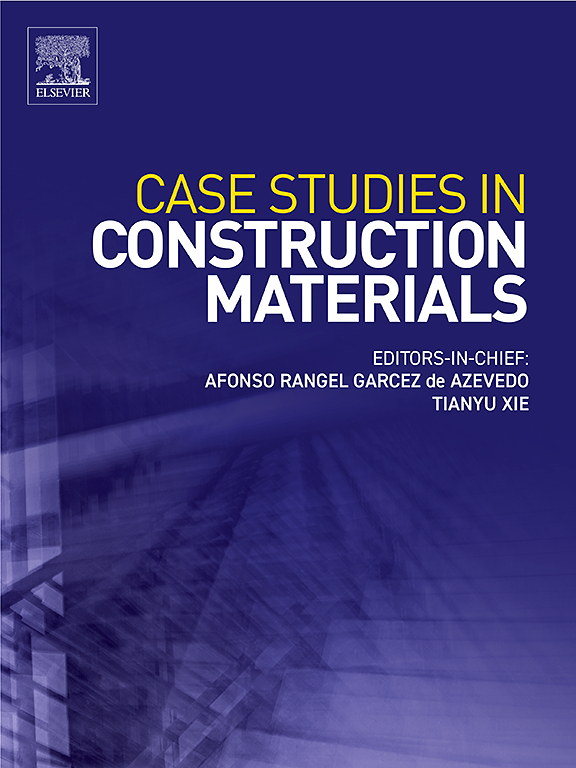Sustainable one-part engineered geopolymer composite with thermal insulation in coastal region: Utilizing red mud dual-function as precursor and activator
IF 6.6
2区 工程技术
Q1 CONSTRUCTION & BUILDING TECHNOLOGY
引用次数: 0
Abstract
Aiming to advance value-added utilization of red mud (RM) for mitigating its environmental footprint, this study strategically leverages its dual-function as both a silicon-aluminum geopolymerization precursor and alkali activator. A sustainable, easy-to-operate, and high-ductility one-part EGC with high RM incorporation and thermal insulation function were successfully developed. The density maintained around 1100 kg/m3, with a low thermal conductivity of 0.35 W/(m·K). Remarkably, EGCs containing 50 % and 80 % RM precursors exhibited compressive strengths exceeding 20 MPa and 10 MPa, respectively, which remained above 10 MPa even at 25 % alkali reduction. In addition, at merely 0.5 % fiber dosage, the EGC demonstrated tensile strength above 2 MPa, strain capacity exceeding 4 %, and controlled crack widths of around 200 μm. The tensile behavior evolution mechanism was revealed by synergistic matrix fracture toughness and fiber bridging capacity. Microstructural analysis revealed that increased RM incorporation and reduced alkali suppressed geopolymerization gel formation, compromising matrix densification while rarely affecting fiber-matrix interfacial bonding. The EGC achieved up to 44 % and 71 % reductions in embodied energy and embodied carbon compared to ordinary concrete, coupled with a 70 % cost reduction compared to conventional M45-ECC. Notably, the fiber-free matrix mortar attained cost parity with ordinary concrete. This work can provide an important reference for the preparation of sustainable and low-cost one-part EGC with thermal insulation function by recycling a large volume of RM.
海岸带可持续单组分工程地聚合物复合材料:利用赤泥作为前驱体和活化剂的双重功能
为了促进红泥(RM)的增值利用以减轻其环境足迹,本研究战略性地利用了其作为硅铝地聚合前驱体和碱活化剂的双重功能。成功研制了一种可持续、易操作、高延展性、具有高RM掺入率和保温功能的单件式EGC。密度维持在1100 kg/m3左右,导热系数为0.35 W/(m·K)。值得注意的是,含有50% %和80% % RM前驱体的EGCs的抗压强度分别超过20 MPa和10 MPa,即使碱还原率为25 %,其抗压强度仍保持在10 MPa以上。此外,当纤维掺量为0.5 %时,EGC的抗拉强度在2 MPa以上,应变容量超过4 %,裂缝宽度控制在200 μm左右。通过基体断裂韧性和纤维桥接能力的协同作用,揭示了拉伸性能演化机制。微观结构分析表明,增加了RM掺入和减少碱抑制地聚合凝胶形成,损害了基质致密性,但很少影响纤维-基质界面结合。与普通混凝土相比,EGC的蕴含能量和蕴含碳分别减少了44% %和71% %,与传统的M45-ECC相比,EGC的成本降低了70% %。值得注意的是,无纤维基质砂浆的成本与普通混凝土相当。本工作可为利用大量废石回收制备具有保温功能的可持续低成本单组分EGC提供重要参考。
本文章由计算机程序翻译,如有差异,请以英文原文为准。
求助全文
约1分钟内获得全文
求助全文
来源期刊

Case Studies in Construction Materials
Multiple-
CiteScore
7.60
自引率
19.40%
发文量
842
审稿时长
63 days
期刊介绍:
Case Studies in Construction Materials provides a forum for the rapid publication of short, structured Case Studies on construction materials. In addition, the journal also publishes related Short Communications, Full length research article and Comprehensive review papers (by invitation).
The journal will provide an essential compendium of case studies for practicing engineers, designers, researchers and other practitioners who are interested in all aspects construction materials. The journal will publish new and novel case studies, but will also provide a forum for the publication of high quality descriptions of classic construction material problems and solutions.
 求助内容:
求助内容: 应助结果提醒方式:
应助结果提醒方式:


